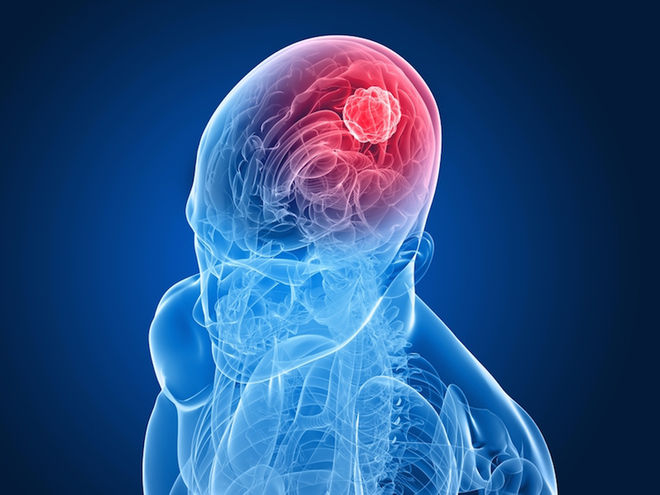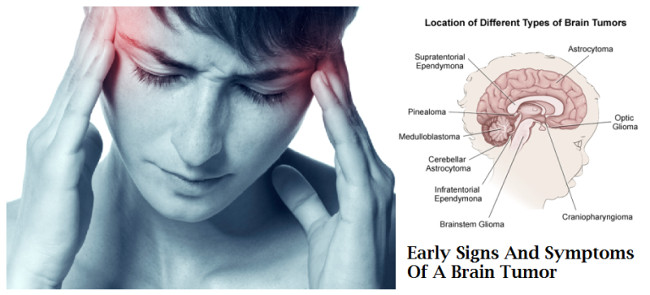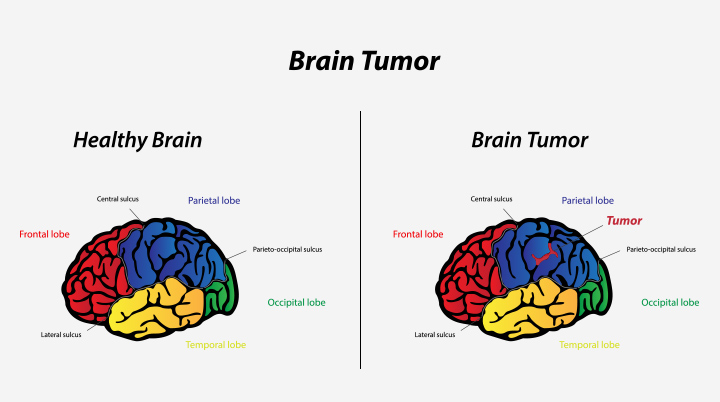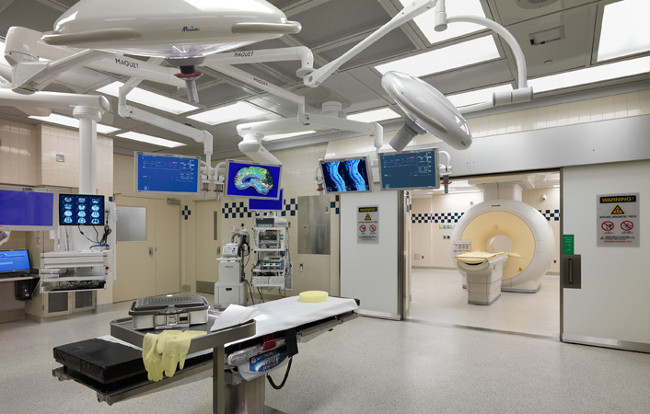Things you need to know about brain cancer
Brain cancer - a brain tumor is a mass or growth of abnormal cells inside the brain or near the patient's brain. There are many types of brain tumors, including benign and malignant tumors (also known as cancer). Cancer cells can begin to form in the brain (primary brain tumor), or cancer can start in other parts of the body and then spread to the brain called metastatic brain tumors (metastatic brain tumor). Brain cancer can alter a person's behavior and endanger his life.
Fortunately, many people will never suffer from this evil disease. According to the American Cancer Society, the risk of getting a malignant tumor in the brain or spinal cord is less than 1%, which means that only 1 in 140 men and 1 in 180 women can get it. this disease.

Brain cancer is caused by abnormal growth of cells in the brain tissue of patients.(Photo source: Sebastian Kaulitzki / Shutterstock.com)
Causes of brain tumors
Brain cancer is caused by the growth of abnormal cells inside the patient's brain. Anaplastic astrocytomas and glioblastomas account for about one-third of all adult brain tumors and astrocytomas are astrocytomas. The most common brain is common in children, according to the National Cancer Institute. Grade III mitochondrial astrocytes, astrocytes brain tumors and brain tumors are developing from brain cells called astrocytes, surrounded and protected by other nerve cells. Brain cancer is distinguished by "levels", each of which is normal or abnormal in the brain and is divided from level I to level IV.
Symptoms of brain cancer

"Because the brain is the center of all body activity, the tumor in this area can affect other areas of the body. The most common symptoms of brain cancer are headaches. , convulsions, weakness, paralysis, personality changes or behavior, "said Dr. Andrew E. Sloan, director of the Center for Brain Cancer and also professor and vice president of the Department of Neurosurgery. at the Medical University - Seidman U Hump Center in Cleveland, Ohio.
The Mayo Clinic also lists the symptoms of brain cancer:
- Difficult to say, hard to hear
- Frequent headaches, headaches and more and more serious
- Nausea or vomiting of unknown causes
- Have vision problems such as blurred vision, illusion or peripheral vision loss
- Gradually lose feeling or cannot move in one arm or one leg
- Confusion in everyday problems
- Difficult to balance
- Change personality or behavior
"Headaches are often associated with brain cancer, but some people have it without experiencing the above symptoms. However, it rarely happens," Sloan said.
"Headaches, headaches are a sign that normal tumors are putting pressure on the brain and increasing intracranial pressure. So headaches can occur often, if the size of the block The tumor is large enough, and the location of the tumors is very important, depending on the area of the brain affected, the appearance of other symptoms such as illness, paralysis, seizures, memory loss or difficulty talk, etc. "- neurosurgeon Dr. Charles Park, director of the Center for Low-Invasive Brain and Spinal Surgery at Mercy Medical Center in Baltimore, Maryland.
There are several symptoms that many people often do not experience when a tumor is present in the brain."A tumor on the right side of the head of the brain (above and behind the right ear) can cause what is known as a" coordinated coordination disorder. " Many people can walk, talk and do things in a normal way but cannot determine everything properly and wear their own clothes, for example: someone will put his pants on his head " - Dr. Michael Schulder, a neurosurgeon specialist and director at the Brain Cancer Center at Northwell Neuroscience Science Institute in Manhasset, New York, said.
Diagnosis of brain cancer

If a healthcare worker suspects a patient has brain cancer, he or she will refer the patient to a specialist. Auditory, vision, coordination, balance, flexibility, health status or reflexes to find abnormalities can indicate brain cancer. Experts can also apply magnetic resonance imaging (MRI), computerized tomography (CT), and Positron tomography (PET) scans to find a block u, according to the Mayo Clinic clinic.
If a tumor is found, a biopsy will be arranged immediately.A biopsy is a procedure for small tissue sampling from a body part for testing. Biopsy is used to identify tumors - benign or malignant cancer.
Treatments for brain cancer

"There are many ways to treat brain cancer. Treatment for brain cancer also depends on where the tumor is located, how it grows and whether it is benign or malignant. Some Treatments include surgery, chemotherapy, radiotherapy, radiotherapy and radiotherapy, " said the Mayo Clinic. The survival rate of people diagnosed with brain cancer varies, depending on the type of cancer, progress and some other factors.
Although many reality dramas and TV shows often show viewers that most brain cancers are inoperable, that is not true. Schulder explains: "There are almost no exceptions, at least biopsies can be carried out in some people with cancer, if nothing changes ."
"In the future, imaging technology such as magnetic resonance imaging (MRI) may replace biopsy, but that is very far in the future, or it may never happen. , the use of modern techniques of microsurgery, magnetic resonance, surgical monitoring and surgical imaging, most brain tumors are surgically removed. The best time to remove the tumor is as soon as possible, " Schulder said.

The magnetic resonance system is fitted with a system of rails on the ceiling.
"It is not possible to have other surgery defined by different surgeries, estimating the average number of brain tumors, on average, neurological surgeries in the United States usually operate about 2 to 3 times a year. Experts at brain cancer centers such as UH-Seidman Cancer Center often operate about 60-100 brain tumors a year, depending on each individual and different tumors. While some complex tumors may be "uncontrollable" for a practical neurological surgery in general, many people have surgery, only a "rare" tumor cannot actually be operated on. then new experts use special devices such as operating rooms combined with magnetic resonance imaging, stereotaxis radiation, images h Fluorescence of tumors (eg 5-ALA), treated by the method of using thermal laser light (Litt), . " , Sloan said.
For example, dangerous malignant tumors of the corpus luteum, called "butterfly gliomas", suggest that "can not be operated" but are now able to operate using LITT.
" Brain tumors are in an inoperable position, if they are in the" very dangerous "or" very important "position of the brain with essential functions ," Park explained. Trying to remove the tumor, a surgery can do a lot of harm to the brain and the patient may be in a coma or become a plant. In this case, the danger is greater than the benefit. "This is a very small percentage. However, most of them will be treated with surgical radiation , " Park added.
In general, tumor pathology and surgery, health status, disease prediction, calculation and subsequent quality of life are carefully considered before considering surgery.
You should read it
- Researchers have figured out how breast cancer spreads to the brain
- Children who survive a brain tumor have a very high body fat content
- 7 symptoms of early cancer are often neglected by 90% of people
- Exposure to pesticides during pregnancy increases the risk of brain tumors in children
- Will Zika virus treat brain cancer?
- Rest assured, phone radiation does not affect people
- New medical technology: Lasers plus 'mini' craniotomy helps burn and smoke brain tumors safely
- Researchers found new antibodies to kill cancer cells
- Doing this 30 minutes a day will help young people at least 25 years old, Steve Jobs used to be and always be creative like his twenties!
- Officially identified the target receptor for the treatment of neuroblastoma
- Science uses dogs to directly study breast cancer
- How does daily activities affect the brain?
May be interested

7 simple ways to reduce air pollution in your home

The first aid procedure Heimlich had when he got a heterozygous object

Even after quitting, after six months, the cigarette quality still exists around you

Warning: Frequently drinking alcohol overdose reduces cognitive function in the elderly

Fat in corn, coconut oil increases the risk of developing intestinal tumors

How to prevent and treat dry eyes effectively






 Researchers have figured out how breast cancer spreads to the brain
Researchers have figured out how breast cancer spreads to the brain Will Zika virus treat brain cancer?
Will Zika virus treat brain cancer? WHO gives conclusion on 'do mobile phones cause brain cancer?' controversy
WHO gives conclusion on 'do mobile phones cause brain cancer?' controversy 7 symptoms of early cancer are often neglected by 90% of people
7 symptoms of early cancer are often neglected by 90% of people Rest assured, phone radiation does not affect people
Rest assured, phone radiation does not affect people Doing this 30 minutes a day will help young people at least 25 years old, Steve Jobs used to be and always be creative like his twenties!
Doing this 30 minutes a day will help young people at least 25 years old, Steve Jobs used to be and always be creative like his twenties!